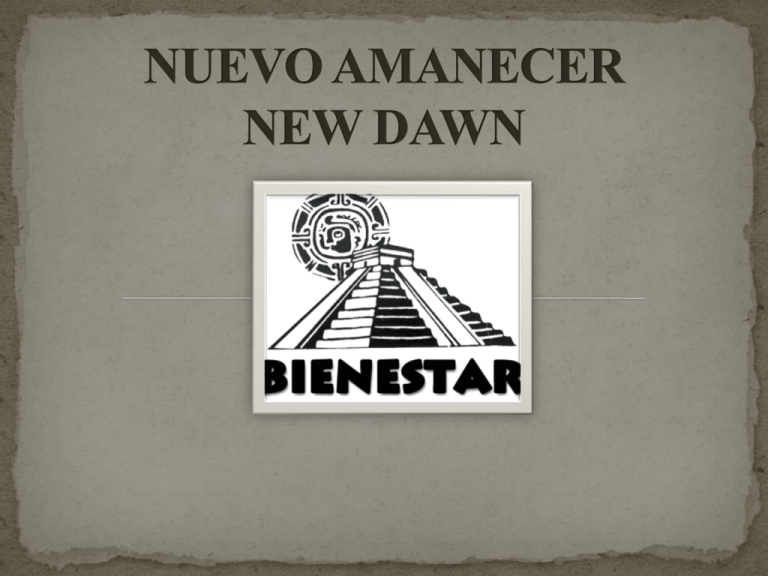
Mission Statement
Client Demographics
Presenting Problems
Dual Identity
Program Goals & Objectives
Description of Program
Program Accomplishments and Outcomes
BIENESTAR is committed to enhancing the health
and well-being of the Latino community and other
underserved communities impacted by poverty,
HIV/AIDS, substance abuse, mental illness and
issues relating to gender identity and/or sexual
orientation.
BIENESTAR accomplishes this through
community education, prevention, mobilization,
advocacy and the provision of direct social support
services.
Provide a safe and substance abuse free
environment
Reduce and/or eliminate the use of substances
Reduce high risk sexual behaviors
Reinforce healthy and effective coping skills to
manage life stressors and triggers of substance
abuse
Goal for end of year 3: 260
Currently: 235
For today’s presentation: 138
Demographics
Age
Category
18 to 24
25 to 29
n (%)
59 (43%)
79 (57%)
Education
Less than 12th grade
12th
Grade/Diploma/GED
More than 12th grade
66 (48%)
40 (29%)
32 (23%)
Living status
Shelter
Street/Outdoors
Housed
Full time
Part time
Unemployed
Other
5 (4%)
7 (5%)
126 (91%)
39 (28%)
38 (28%)
58 (42%)
3 (2%)
Employment
During the past 30 days, did you use any of
following?
Yes
n (%)
Cocaine/Crack
13 (9%)
Marijuana/Hashish
64 (46 %)
Methamphetamines or other
amphetamines
47 (34%)
Inhalants
26 (18%)
During the past 30 days, how many days
have you used any alcohol?
Category
0
1 – 10
11 – 20
21 – 30
Frequency
%
30
68
36
4
22%
49%
26%
3%
In the Past 30 days, not due to your use of
alcohol or drugs, how many days have you …
Average
days
Experienced serious depression
8.25
Experienced serious anxiety or tension
7.83
Experienced trouble understanding, concentrating
or, remembering
4.05
Experienced trouble controlling violent behavior
1.05
Religious &
Cultural
Messages
Substance
Use/Abuse
SelfDestructive
Behaviors
YMSM
of
Color
Internalized
Homophobia
Family
Rejection
Assist clients to:
Live a healthy and substance-free life
Repair relationships impacted by substance use
Process thoughts and feelings related to childhood
and adolescent trauma/abuse
Repair their self-esteem
Address issues related to sexual orientation
Lower their risk for HIV infection if HIV-negative
Engage in HIV medical care and cope with HIV
constructively if HIV-positive
Program Components
Individual, group and/or family therapy
Substance abuse counseling
Substance abuse and 12-step support
groups
HIV & hepatitis C testing and education
Weekly substance abuse screening
Free
Confidential
20-weeks of treatment
Personalized individual treatment plan
Interdisciplinary team: mental health clinicians,
substance abuse counselors and peer counselors
Services can be provided at the San Fernando Valley,
East Los Angeles and Hollywood Bienestar offices
Ages: 18-29 years old
Target population: Latino men
Sexual orientation: Gay, bisexual and other men who
have sex with men (MSM)
Presenting problem: Substance abuse or have cooccurring substance abuse and mental health illness
Admission into the program is not affected by HIV
serostatus, income level, immigration status or
sobriety.
Matrix Model adapted for gay men, “Getting
Off”
Cognitive Behavioral Therapy
Motivational Interviewing
Goals
Reduce drug use and high risk sexual behaviors
Link drug use with high risk behaviors
Address co-factors for HIV infection and transmission
Techniques
Gay-specific Cognitive Behavioral Therapy (CBT)
Skill building
Abstinence promotion
Intervention
CBT group sessions
Support groups
Urine samples
Assessment stage: building a therapeutic relationship
between therapist and client; identifying central issues;
forming a treatment plan; determining treatment length
Cognitive stage: understanding client’s thoughts; discussing
significant past events
Behavior stage: identifying new patterns of thinking;
applying new patterns of thinking to new behaviors
Learning stage: identifying techniques to assure that the
changes are permanent
Express empathy: use of non-judgmental
reflective listening
Develop discrepancy: contrast present
behavior with broader goals
Avoid argumentation: use of soft confrontation
and persuasion
Roll with resistance: involve client in the
process of problem solving
Support self-efficacy: increase client’s
perception of his ability to cope with obstacles
and succeed in change
3 masters-level clinicians (MSW)
Clinical supervisor (LCSW)
Program evaluator (MSW, Ph.D.)
Masters-level biostatistician (MS)
Certified substance abuse counselor
Certified HIV/hepatitis C tester/counselor
2 outreach workers
Peer counselor
Drug use
Marijuana/ hashish
Methamphetamines or other amphetamines use
Inhalants
Any illegal drug use
Alcohol use
Any alcohol
Alcohol to intoxication (5+ drinks in one sitting)
Mental health
Serious depression
Serious anxiety or tension
Trouble understanding, concentrating or remembering
Trouble controlling violent behavior
During the past 30 days, how
many days have you used
Baseline
6 month
follow-up
Marijuana/hashish
4.97
2.57
Methamphetamines or other
amphetamines
3.90
0.92
Inhalants
1.73
0.30
Any illegal drugs
9.15
3.51
During the past 30 days, how
many days have you used
Baseline
6 month
follow-up
Any alcohol
8.20
3.83
Alcohol to intoxication
(5+ drinks in one sitting)
4.21
2.28
In the Past 30 days, not due to
your use of alcohol or drugs,
how many days have you …
Baseline
6 month
follow-up
Experienced serious depression
8.50
3.10
Experienced serious anxiety or
tension
8.30
2.90
Experienced trouble
understanding, concentrating or
remembering
4.91
1.73
Experienced trouble controlling
violent behavior
1.09
0.33
Acknowledgements:
•
USCA
• SAMHSA, Dr. Ed Craft
• Bienestar Human Services Inc.
• Audience





